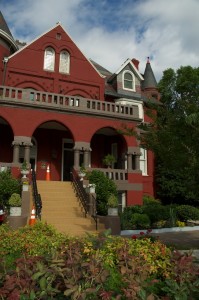In classy Dupont Circle, sip mint juleps in the garden.

Washington D.C. in summer is both inviting and enervating. Because of its sweeping boulevards, ceremonial spaces and numerous monuments, you’ll be happier on a bike than walking or driving. Pick up a bike from Bike and Roll and off you go. Cycle to the national monuments in a single day, taking a break in the hidden gardens whenever you spot an entrance.
Away from the National Mall, the city slips into low gear. Warm weather and the profusion of greenery cajole residents into lingering by fountains and reading books under the maple trees.
Take your cue from the locals and settle into the classy Dupont Circle Historic District. Summer shows its gaiety and grandeur. Hydrangeas take over mansion gardens and clematis creep atop ornate ironwork.

For a dose of old-world domestic bliss, stay at Swann House, a red brick Victorian with a terrace, turrets and a swimming pool. The drawing room looks the same as it did in 1912 when President Taft attended a wedding in which the bride wore ivory panne velvet and descended the stairs to the music of Chopin’s Nocturne.
During the Gilded Age, the city’s high society built Beaux Arts mansions to entertain during the social season. Foreign dignitaries expected grand settings. The opulent residences of the Dupont Circle Historic District now serve as embassies, private institutions and museums. Some take up a full block with as many as 50 rooms done up in marble floors, carved wood walls, murals and gilded ceilings.
Spend the morning at the opulent 19th century mansion housing the Phillips Collection. Priceless impressionist paintings hang in the grand rooms. In the wood-paneled music room is George Braque’s “Philodendron” and in the upstairs sitting room Renoir’s “Luncheon of the Boating Party.”
Have lunch at Boqueria, the D.C. branch of a New York tapas bar and restaurant neighborhood. This eatery caters to the neighborhood’s aficionados of good food with an elegant dining room and exotic menu. The shaved fennel with avocado and marinated shrimp is light and refreshing. Among the classic tapas are the grilled lamb and potato omelet.

Walk over the Dumbarton Bridge to Georgetown Heights to visit a sprawling country estate. Dumbarton Oaks, built in 1801, displays a map in the music room showing its original boundaries. As a showcase venue, the estate hosted important diplomatic discussions in 1945 that led to the signing of the United Nations Charter. The home and modern pavilion now display artwork and artifacts from the Roman, Byzantine, Aztec and Inca empires. Don’t miss the horticulture treasures in the estate garden and arboretum.

Gardening has also been taken up by restauranteurs. The Eat Well Natural Farm in La Plata, Maryland makes daily deliveries to The Pig restaurant. On a recent summer evening, chef Garret Fleming whipped up cassoulet with pork, lamb, tomatoes, grits and charred arugula. His restaurant has been packed since the second week of opening. Another favorite dish is the boar spoonbread with truffles and mushrooms. The dishes come with ingenious sauces and condiments like romesco sauce, watermelon jam, herb yogurt and candied tomatoes.

As you walk back to the Swann House, look for the Dupont Circle call boxes. Installed in the 1860s and abandoned, the emergency call boxes were decaying relics until artists and historians spruced them up. The colorful call boxes now sport original artwork and interesting location notes. Call box #3 describes the block-size mansion nearby at 1801 Massachusetts Ave, once the winter residence for wealthy New York couple, then the Red Cross headquarters during World War II now the Embassy of Iraq.
The current residents are keeping up the place. Dupont Circle has a flavor all its own that alternates between frangipane and watermelon sorbet.
—by Donna Peck. Photography by Donna Peck and Washington.org.






Leave a Reply